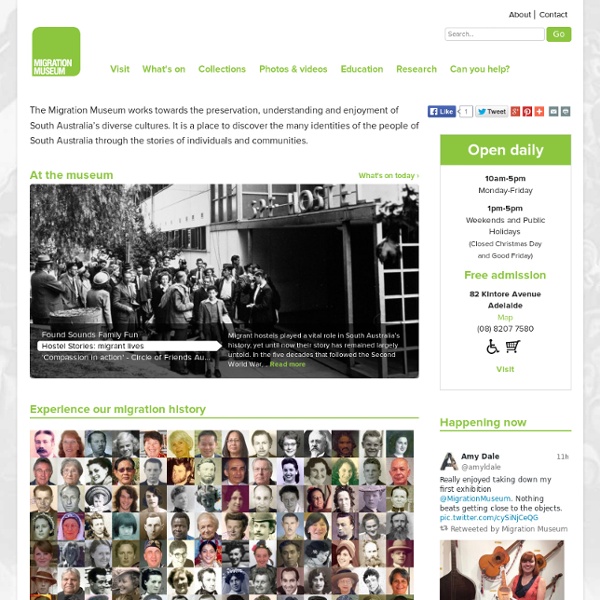



Art Gallery of South Australia :: Visit :: Visit - Iceweasel Founded in 1881, the Art Gallery of South Australia is home to one of Australia's great art collections, housed in one of Adelaide's most beautiful buildings. Located at the heart of Adelaide's cultural boulevard, North Terrace, between the South Australian Museum and University of Adelaide, the Art Gallery welcomes more than half a million visitors each year. Opening Hours 10am to 5pm (closed 25 December) A printable PDF floorplan of the Art Gallery is available here. Admission General admission is free. Charges apply for some exhibitions. The CollectionThe Art Gallery's outstanding collection of 38,000 works of art comprises Australian, European, North American and Asian works including paintings, sculptures, prints, drawings, photographs, textiles, furniture, ceramics, metalwork and jewellery. Public ProgramsWe offer a dynamic program of exhibitions, educational programs and events. ParkingParking is available opposite the Art Gallery in the Wilson’s Carpark on North Terrace.
Home Page - Iceweasel South Australian Public Library Network - Welcome - Iceweasel Skip to main navigation Dads Read Be their reading legend. Reading just 10 minutes a day makes a difference For more information Experience something new! There's always something happening in today's public libraries... More Events Spotlight - Roxby Downs Community Library After several years in the planning, eight months as a building site and more than $1 million, the doors of the state’s newest and rather remote library in Roxby Downs were recently opened. Read More More Online Resources Copyright|Disclaimer|Privacy|Credits|Site Map Giving an Oral Presentation : Academic Skills Centre : University of Canberra - Iceweasel Preparing your oral presentation First of all, think ... Think about what you want to achieve: do you want to inform your audience, inspire them to think about your topic, or convince them of a particular point of view? Think about your audience: what background knowledge do they have about your topic? Do they have any particular interests? How are you going to involve them in your presentation? Then ... Brainstorm your topic and write a rough outline. Organising the content Introduction (may be written last) Capture your listeners’ attention: Begin with a question, a funny story, a startling comment, or anything that will make them think. The Body Present your main points one by one in logical order. The Conclusion It is very important to leave your audience with a clear summary of everything you have covered. Delivering your presentation Talk to your audience, don't read to them! A presentation is not the same as an essay. Watch your language! Keep it simple. Use your body to communicate, too!
Handbook on Report Formats - Iceweasel Summary: This resource is an updated version of Muriel Harris’s handbook Report Formats: a Self-instruction Module on Writing Skills for Engineers, written in 1981. The primary resources for the editing process were Paul Anderson’s Technical Communication: A Reader-Centered Approach (6th ed.) and the existing OWL PowerPoint presentation, HATS: A Design Procedure for Routine Business Documents. Contributors:Elizabeth Cember, Alisha Heavilon, Mike Seip, Lei Shi, and Allen BrizeeLast Edited: 2013-03-11 10:28:48 Report Formats An overview of the how, what, and why of organizing different types of reports How do you select a format and use it? Purposes and types of report formatsParts of a reportSpecific advice for writing reports What is format? A plan of organizationA means of structuring materialA framework for arranging information Why should you use a format? Your readers Before you write a report, you must consider your readers. Who are my readers? General report format guidelines
Essay Writing - Iceweasel Summary: The Modes of Discourse—Exposition, Description, Narration, Argumentation (EDNA)—are common paper assignments you may encounter in your writing classes. Although these genres have been criticized by some composition scholars, the Purdue OWL recognizes the wide spread use of these approaches and students’ need to understand and produce them. Contributors:Jack Baker, Allen Brizee, Elizabeth AngeliLast Edited: 2013-03-01 08:12:47 This resource begins with a general description of essay writing and moves to a discussion of common essay genres students may encounter across the curriculum. Overview The essay is a commonly assigned form of writing that every student will encounter while in academia. Essays can be a rewarding and challenging type of writing and are often assigned either to be done in class, which requires previous planning and practice (and a bit of creativity) on the part of the student, or as homework, which likewise demands a certain amount of preparation.
Skills4Study.com: Study Skills - Iceweasel Home > Study skills > Learning strategies > Reading strategies Being able to read effectively means more than just being able to understand what is written on the page. In this section, you can explore different reading strategies to ensure your reading, and in turn your assignments, are first-class. Reading for different subjects Different reading strategies are needed for different subject disciplines, and even for different kinds of writing within the same subject. You may also be asked to read about the same topic from different angles. Science subjects tend to require slower and closer reading of smaller amounts of text. Reading for any subject 1. 2. 3. 4. 5. 6. Reading for different purposes For all subjects, you will need to know how to change quickly from one kind of reading to another. 1. 2. 3. 4. 5. Reading for understanding The main purpose of reading is to understand - not to get through text at speed for the sake of it. 1. 2. 3. 4. 5. 6. 7. Change the text 1. 2. 3. 4. 5.
APMF Asia Pacific Mediation Forum | APMF peace through mediation - Iceweasel History Channel - Lost Worlds - Atlantis (Complete Documentary) - YouTube - Iceweasel Astrology & Free Horoscopes Complete Zodiac Sign Information - Iceweasel